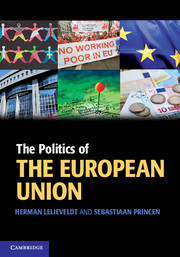Book contents
- Frontmatter
- Contents
- Acknowledgements
- List of briefings
- List of fact files
- List of controversies
- List of tables
- List of figures
- List of abbreviations and acronyms
- List of country abbreviations used in tables and figures
- Preface
- PART I Setting the scene: origins, analytical perspectives and institutions
- 1 The historical development of the EU
- 2 Analysing the EU
- 3 The institutional framework
- 4 Legislation and decision-making: putting the institutional puzzle together
- PART II Key actors in EU politics: citizens, interest groups and political parties
- Part III EU policies: agenda-setting, decision-making and implementation
- Conclusions and reflections
- Key terms and concepts
- Index
1 - The historical development of the EU
from PART I - Setting the scene: origins, analytical perspectives and institutions
- Frontmatter
- Contents
- Acknowledgements
- List of briefings
- List of fact files
- List of controversies
- List of tables
- List of figures
- List of abbreviations and acronyms
- List of country abbreviations used in tables and figures
- Preface
- PART I Setting the scene: origins, analytical perspectives and institutions
- 1 The historical development of the EU
- 2 Analysing the EU
- 3 The institutional framework
- 4 Legislation and decision-making: putting the institutional puzzle together
- PART II Key actors in EU politics: citizens, interest groups and political parties
- Part III EU policies: agenda-setting, decision-making and implementation
- Conclusions and reflections
- Key terms and concepts
- Index
Summary
Introduction
To most European citizens the Ninth of May will be a day just like any other. In Brussels, Luxembourg and Strasbourg however, this is different. In these cities a sizeable number of people work for one of the institutions and organizations of the European Union (EU). If we follow the official historiography of the EU, their jobs found their origin in a press conference held sixty years ago by the French Minister of Foreign Affairs, Robert Schuman. On 9 May 1950 he proposed a plan that laid the foundation for today's European Union by proposing to set up a European Coal and Steel Community (ECSC).
In 1985 the leaders of the member states of the EU decided that it would be good to celebrate this day as Europe Day. But most citizens will not notice this. Maybe this is not surprising given the fact that the day marks a rather obscure event in history. After all, commemorating a press conference is quite different from celebrating a rebellion (like the USA's Fourth of July) or a revolution (such as France's Quatorze Juillet).
Despite its humble origins, the EU has in the meantime developed into a political system that seriously impacts the lives of these same citizens. Within a timespan of only sixty years it has established itself as a unique form of political cooperation comprising 27 member states and 500 million inhabitants, with a combined income that is the world's largest.
- Type
- Chapter
- Information
- The Politics of the European Union , pp. 3 - 30Publisher: Cambridge University PressPrint publication year: 2011



